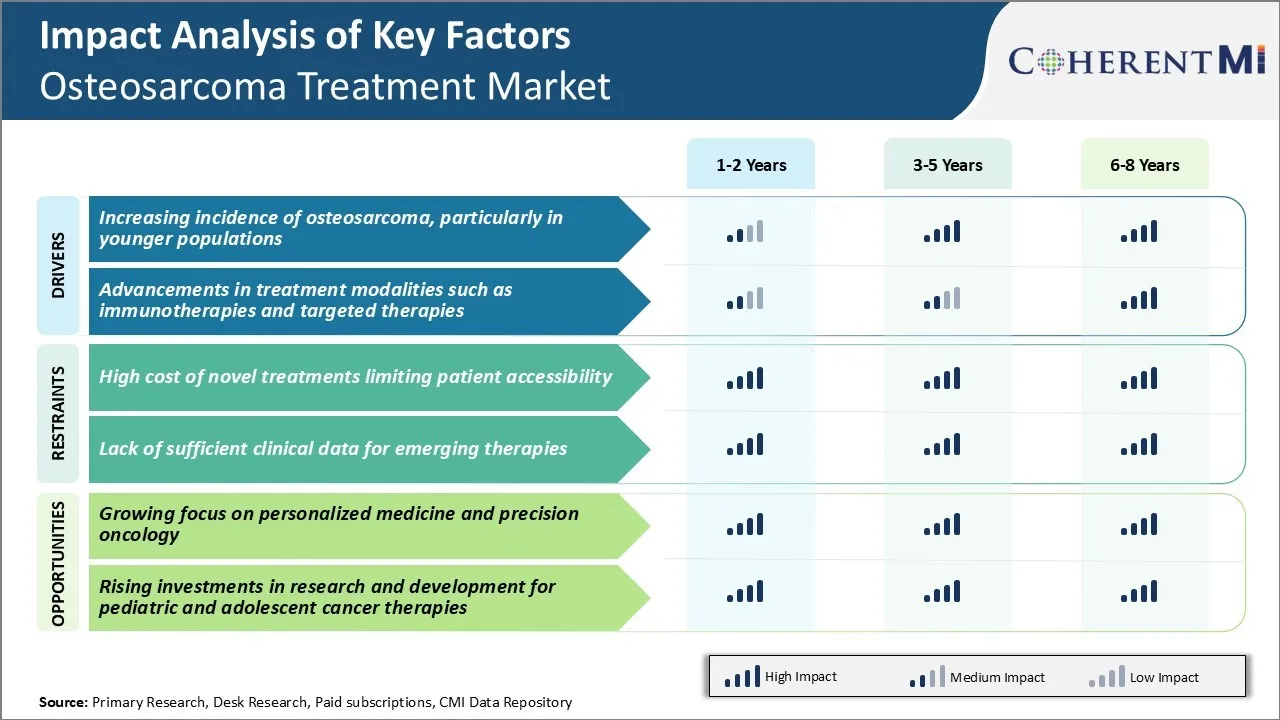Osteosarcoma Treatment Market Trends
Market Driver - Increasing Incidence of Osteosarcoma, Particularly in Younger Populations
Statistics show the annual incidence rate of osteosarcoma to be around 4 cases per million individuals. Studies from North America and parts of Europe have found the average annual incidence amongst adolescents aged 10-24 years old to be over 8 cases per million. Even more alarmingly, some Asian countries have reported adolescent rates as high as 10-12 cases per million people.
The younger patient demographic is a major concern as osteosarcoma diagnosed during childhood or teenage years often indicates a more aggressive form of the disease. Younger bones are still developing which allows the cancerous cells to spread more rapidly. Unfortunately, delayed diagnosis remains common particularly in underdeveloped regions with limited access to advanced healthcare facilities. This contributes to poorer clinical outcomes and reduces overall survival rates.
With global populations continuing to grow and age structures skewing younger in developing nations, the sheer volume of at-risk individuals is increasing yearly. Unless concerted efforts are made to curb underlying hereditary and environmental causes while bolstering early cancer screening programs globally, rising incidence trends will persist and potentially even accelerate in the coming decades. This presents a significant driver for continued research into more effective and affordable therapeutic solutions.
Market Driver - Advancements in Treatment Modalities Such as Immunotherapies and Targeted Therapies
While osteosarcoma remains a difficult-to-treat type of cancer with historically low survival rates, the field of oncology has witnessed tremendous progress in recent years. Advancements in understanding the molecular underpinnings of the disease have enabled the development of novel, targeted treatment approaches. Coupled with rapid technological improvements, this has transformed the osteosarcoma treatment landscape and fueled renewed optimism amongst patients and the medical community.
Immunotherapies harnessing the power of one's own immune system are at the forefront of innovation. Checkpoint inhibitors designed to release brakes on immune responses have shown promise in early clinical trials. These include drugs targeting the PD-1/PD-L1 pathway which many tumors utilize to evade detection. Ongoing studies continue expanding our knowledge of how immunotherapies can best be incorporated into standard chemotherapeutic regimens. Meanwhile, chimeric antigen receptor (CAR) T-cell therapies are also under investigation. By engineering patients' own T-cells to recognize tumor-specific antigens, CAR-Ts have driven complete remissions in blood cancers and hold future potential for solid tumors.
In parallel, molecularly targeted agents inhibiting tumors' aberrant growth signaling pathways have significantly improved outcomes compared to conventional chemotherapy alone. This will have a significant effect on growth of the osteosarcoma treatment market.

Market Challenge - High Cost of Novel Treatments Limiting Patient Accessibility
The cost of novel and advanced treatments for osteosarcoma, such as immunotherapies and targeted therapies, is hugely prohibitive for many patients. These new treatment options offer better survival outcomes compared to traditional chemotherapy regimens.
However, their cost can often run into hundreds of thousands of dollars for a full course of treatment. As osteosarcoma is a rare type of cancer, pharmaceutical companies are unable to realize significant sales volumes for these therapies. This high-risk factor is then reflected in the pricing of these drugs.
The lack of a sizable patient pool makes it financially unviable for companies to offer these novel treatments at affordable price points. As a result, only patients with strong insurance cover or deep pockets have access to latest treatment innovations. This economic barrier severely limits the penetration of advanced care, especially in developing nations.
Even in developed markets, high out-of-pocket costs often force patients to opt for cheaper but relatively less effective options like generic chemotherapy. This presents a significant challenge for improving clinical outcomes at a population level for osteosarcoma.
Market Opportunity - Growing Focus on Personalized Medicine and Precision Oncology for Market
There is a growing focus in the oncology sector on developing personalized and precision-based treatment approaches. This shift offers promising opportunities for the osteosarcoma treatment market. With advances in genetic profiling and targeted diagnostic tests, oncologists now have a better understanding of the molecular characteristics of individual patient's tumors. This allows for more stratified treatment decisions based on a patient's unique genetic signature and biomarkers.
Several pharmaceutical companies are actively investing in researching and developing tailored therapies designed for specific genomic alterations present in osteosarcoma tumors. The insight gained from big data analyses is also helping identify biomarkers that can predict drug responses. This growing focus on personalized medicine and precision oncology aims to maximize treatment efficacy while minimizing toxicity for osteosarcoma patients.
It could potentially lead to improved clinical outcomes. It may also help pharmaceutical players better determine the right patient populations for new drug candidates, improving commercial viability. This shift bodes well for future growth prospects in the osteosarcoma treatment market.